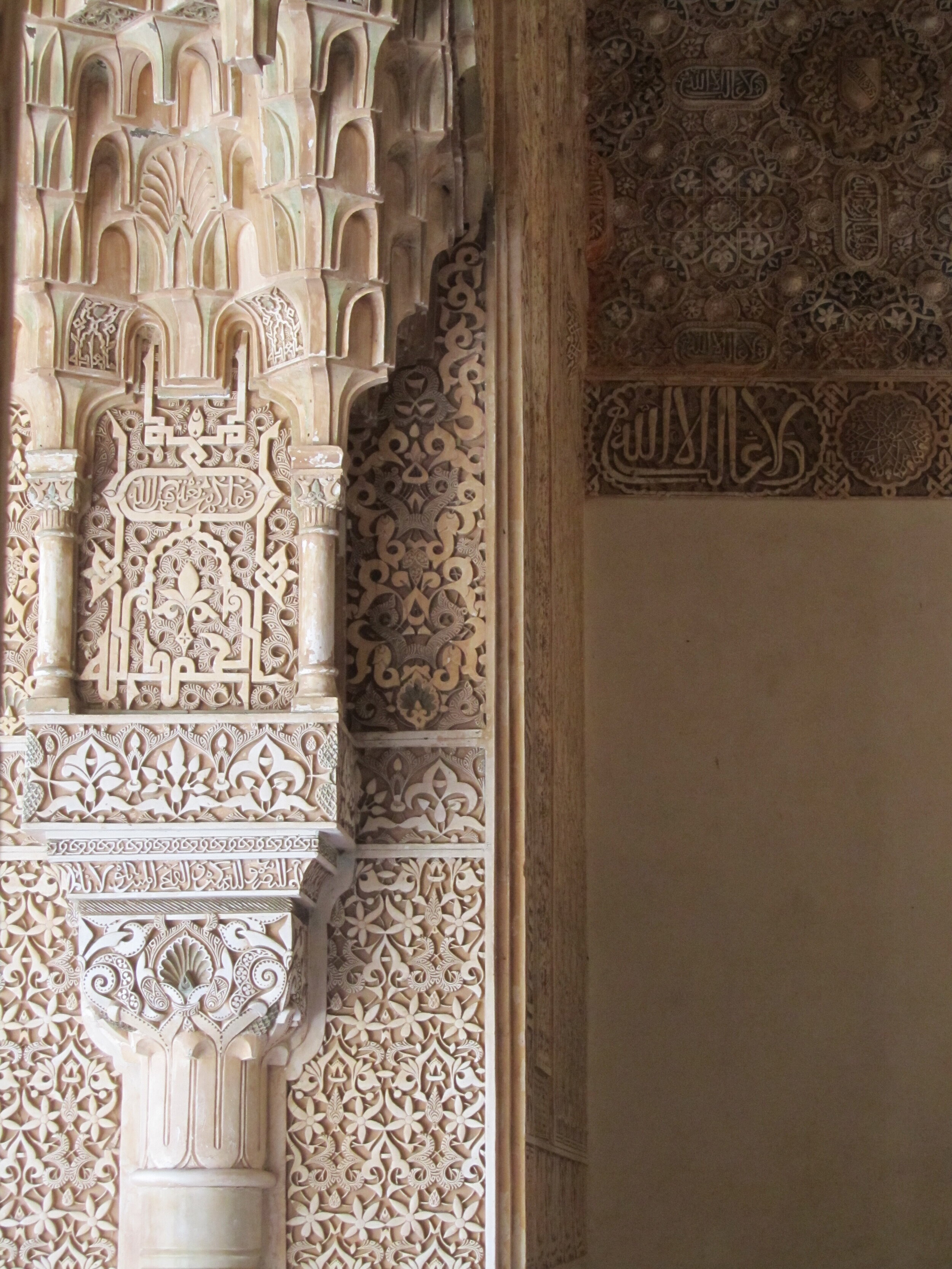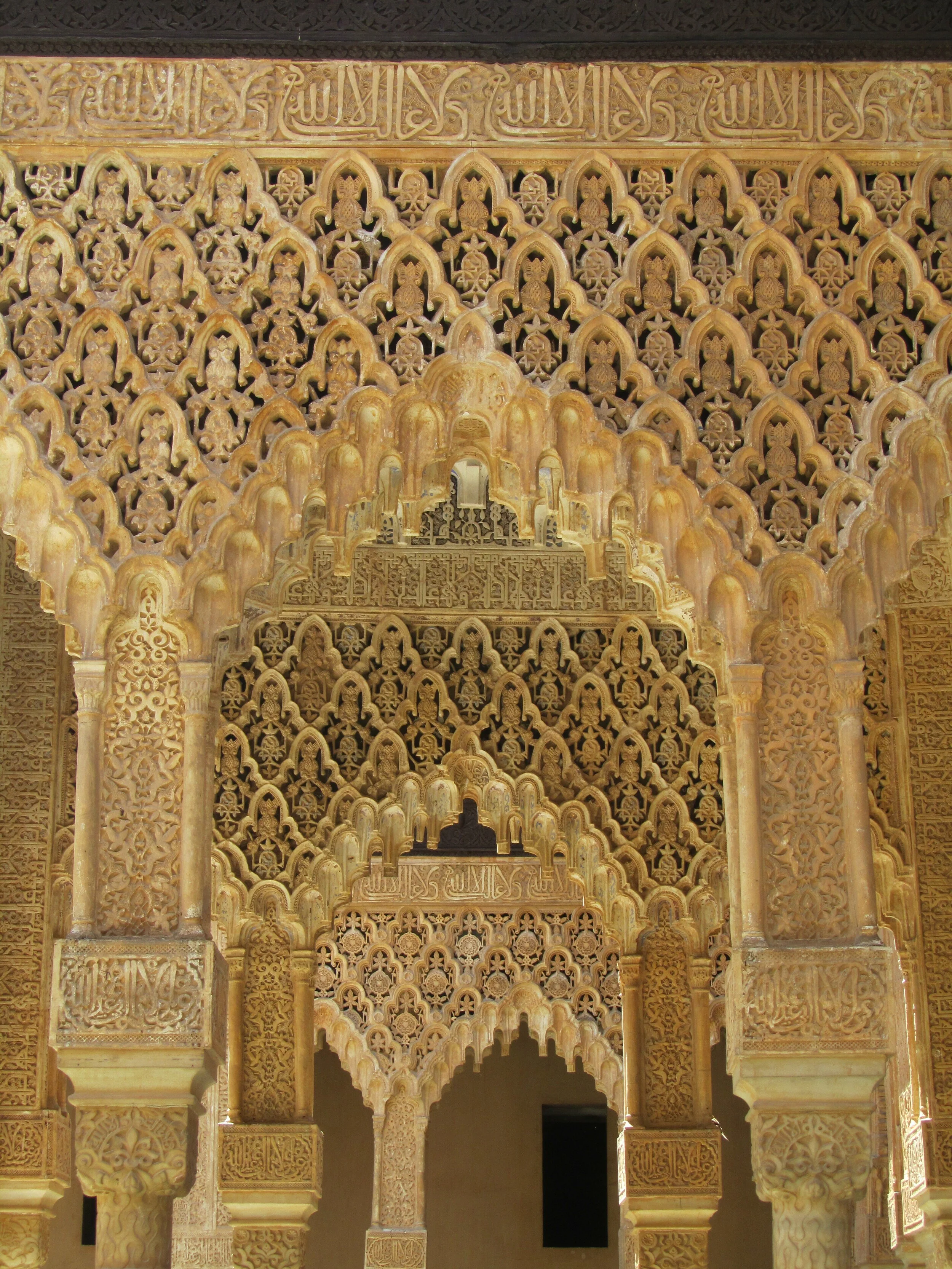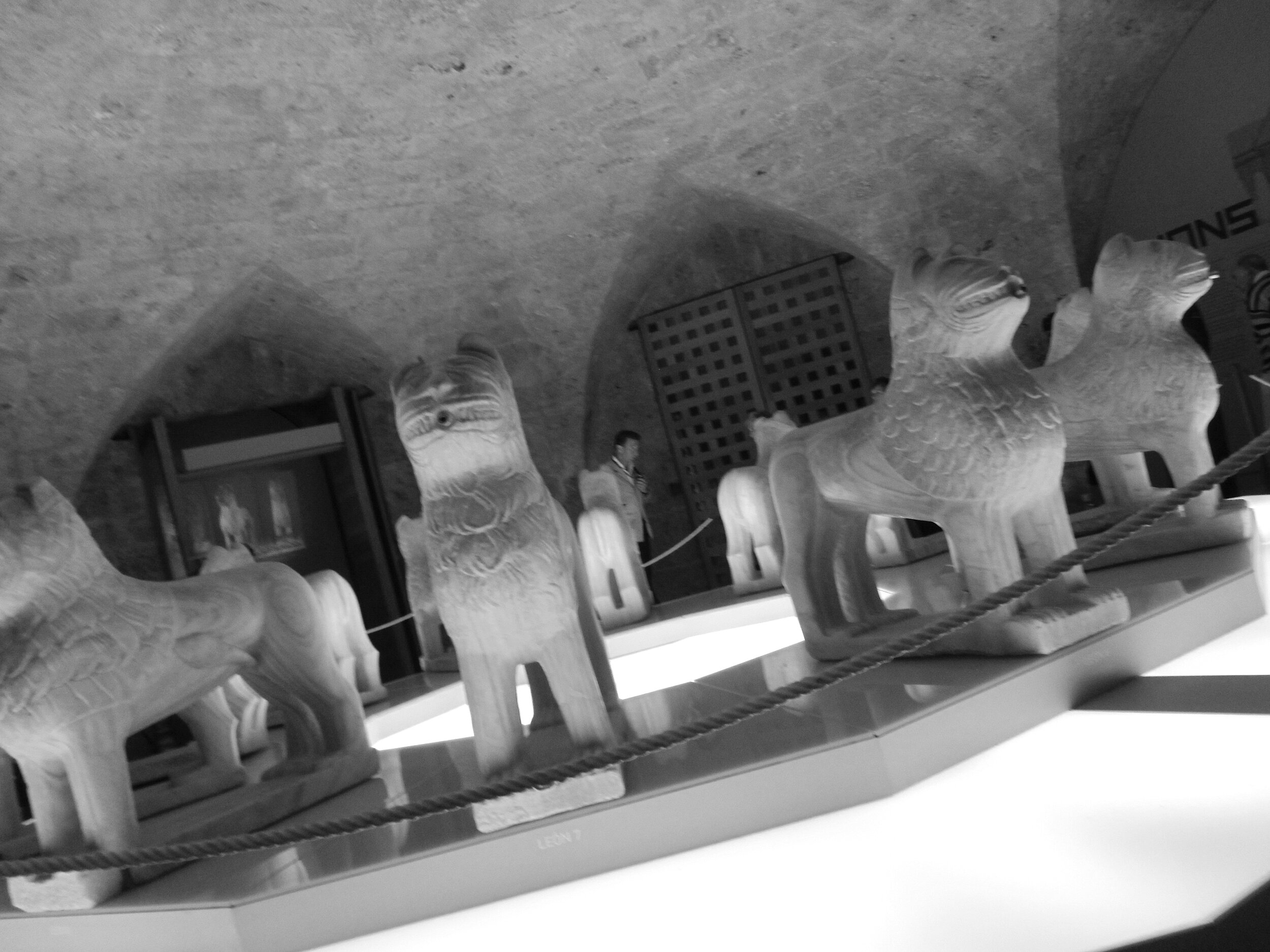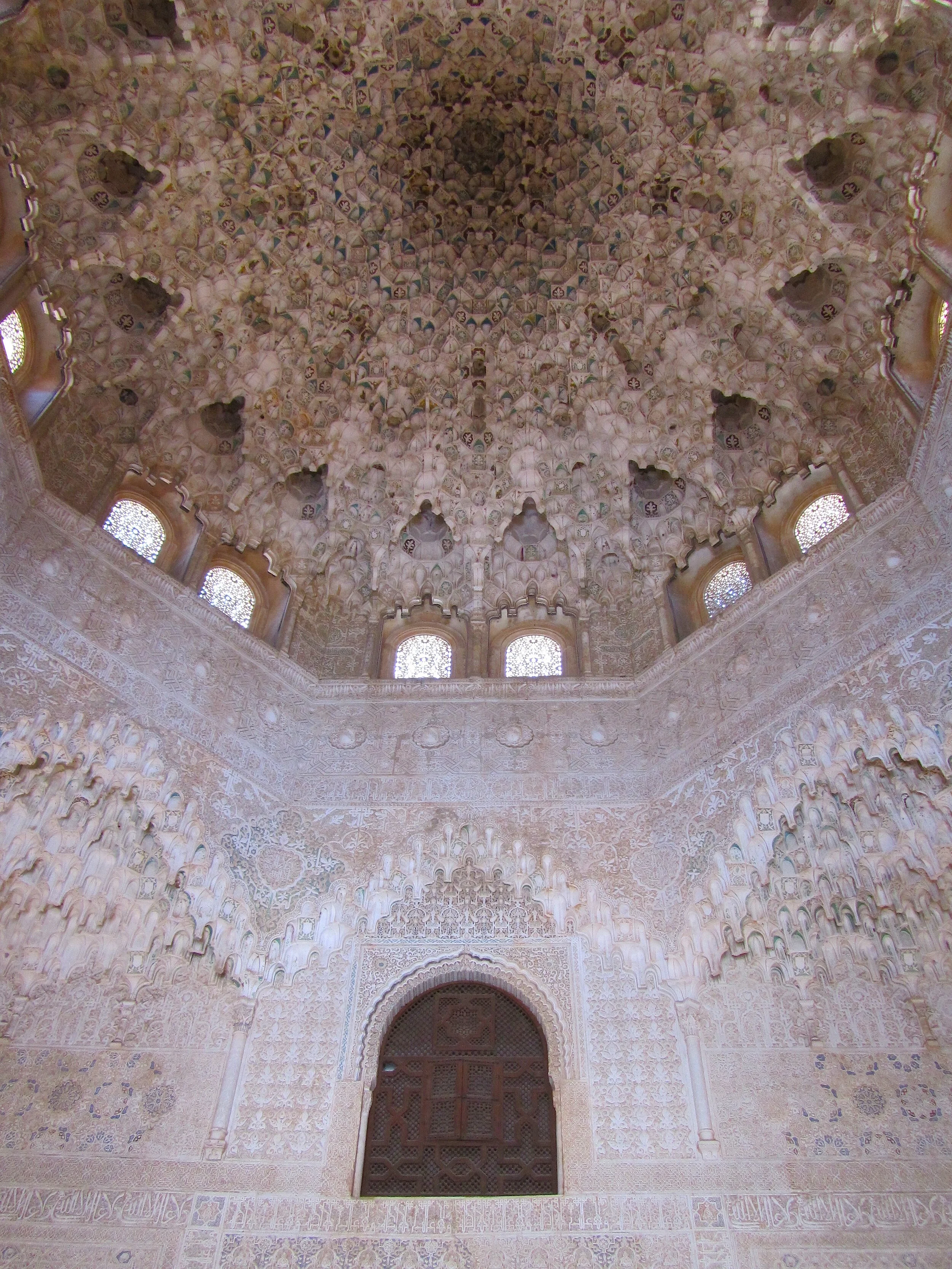No trip to Granada is complete without a tour of the Palacio de los Leones and the Palacio de Carlos V. Learn the colorful history, which includes an explosion and a dinner party massacre.
The Patio de los Leones, with its namesake fountain
The impressive Alhambra complex in the charming town of Granada, Spain is a collection of palaces built at various times during its history. At the heart of the Nasrid Palaces complex is the Palacio de los Leones (Palace of the Lions). It’s likely that the structure was originally independent of the others, with the existing passage between the Comares Palace and the Palace of the Lions added sometime after the Muslim-ruled town of Granada fell to the Christians in 1492.
This was our favorite part of the entire Alhambra complex.
Built at the peak of the Nasrid dynasty, the palace and cloister-like courtyard known as the Patio de los Leones (yes, you guessed it: the Patio of the Lions) was commissioned by Muhammad V during the second half of the 14th century, as a pleasure palace for the emir and his harem.
What Islamic art lacks in depictions of living creatures, it more than makes up for in beautiful patterns.
“It was like something out of “Game of Thrones.”
The sultan invited the chief noblemen of the Abencerraje family to a banquet — and set about unceremoniously massacring all 36 of them.”
Delicate pillars frame restoration work.
The two main structures we’re covering in this post are:
Palacio de los Leones
Palacio de Carlos V
The wall carvings in this section of the Nasrid Palaces are truly spectacular. Can you spot the bird on its peculiar perch?
MORE ALHAMBRA POSTS
Explore the Generalife Gardens
Enter the Alcazaba fortress
Start your Nasrid Palaces adventure with the Mexuar and Comares Palace
Everywhere you look, your vision is filled with stunning architecture and delicate carvings.
At the time of our visit, the palace’s impressive namesake fountain, a polygonal basin supported on the haunches of 12 rather primitive-looking white marble lions, was undergoing restoration. As we passed by the fountain under repair, we were told no photos were allowed. Incidentally, this didn’t prevent Wally from discreetly holding out his camera and snapping an image of the fountain as we passed by.
Wally snuck a shot of the lion fountain while it was under repair.
The fountain is unusual, as representations of living creatures do not typically appear in Islamic art.
The patio is divided into four quadrants, with running water channels symbolizing the four rivers that run through the Islamic idea of paradise: wine, water, milk and honey.
Windows look out upon the greenery, which was watered via ancient aqueducts.
Four Rooms
Slender columns with cubic capitals support the intricately carved arcades of stalactite-like muqarna arches surrounding the perimeter gallery. Its massive chambers open onto the courtyard with the Sala de los Abencerrajes to the south and the Sala de las Dos Hermanas to the north. The other two are the Sala de los Mocárabes, closest to the entrance, and the Sala de Los Reyes, to the west, which was closed during our visit.
The domed ceiling of the Hall of the Two Sisters reminded us of a honeycomb.
Sala de las Dos Hermanas, the Hall of the Two Sisters
The room takes its name from a pair of large white marble slabs set into the floor. Why these slabs were thought to be female relations is anybody’s guess. But the most outstanding feature of the room isn’t its floors — it’s the ceiling. Framed by a symmetrical eight-pointed star illuminated by light that filters through 16 latticed mashrabiya windows, the beautiful honeycombed ceiling of this two-storied hall is nothing short of breathtaking.
The conquering Catholic Monarchs never completed their plasterwork ceiling. It junked up the room, if you ask us.
Sala de Los Mocárabes, the Stalactite Hall of Muqarnas
This room most likely served as a reception hall due to its proximity to the palace entrance. It took its name from a vault of stepped plaster brackets resembling stalactites known as mocárabes, or muqarnas in Arabic, that once covered it. It’s believed that these ornamental vaults were a symbolic representation of the cave where the Angel Gabriel revealed the Qur’an to the Prophet Muhammed. Sadly, these mocárabes were removed due to the explosion of a powder magazine in 1590.
An incomplete plaster ceiling featuring the imperial shield of Felipe II and the initials of Ferdinand of Aragon and Isabella of Castile were added to replace the mocárabes in 1614.
The Slaying of the Abencerrajes by Marià Fortuny, 1870
Sala de los Abencerrajes, Site of a Massacre
This beautiful chamber is steeped in lore and is the site of one of the Alhambra’s most popular legends — like something out of Game of Thrones.
According to one version of the tale, Sa’d, the 20th sultan of the Nasrid dynasty, and his brother Muhammad XIII, were worried about the growing political power of a prominent noble family, whose surname was Abencerraje. The sultan was told that the Abencerrajes were plotting against him. He invited the chief noblemen of the Abencerraje family to a banquet — and set about unceremoniously massacring them. The legend continues, suggesting that the reddish-brown stains on the marble fountain in the center of the hall are traces of blood from the 36 slain Abencerrajes.
With cherubs adorning its exterior, the Palace of Charles V feels very different than the rest of the Alhambra. In fact, it pales in comparison to the ornate opulence of the Palace of the Lions.
Palacio de Carlos V, the Palace of Charles V
Also located within the complex, the extravagant Renaissance-style Palace of Charles V is a striking contrast to the Moorish architecture of the Alhambra. During the occupation of the Christian monarchy, Charles V (1500-1558) visited the Alhambra and decided to build a grand palace there as a wedding gift to his wife, Isabella.
Portrait of Charles V on Horseback by Anthony van Dyck, 1620
The palace was designed in 1528 by Pedro Machuca, though construction didn’t begin until 1553. Unfortunately, the project was abandoned in 1568 before it was completed, owing to the rebellion of the Moors in Granada, and remained unfinished until Leopoldo Torres Balbás devised a plan to restore the building in 1923.
The two-story colonnade that encircles the palace
Its façade is embellished with bronze rings held in the mouths of lion heads, except for the corners, which are held by eagles. Inside is a circular peristyle courtyard. It felt like the interior of the Colosseum, with visitors strangely exposed from every angle.
The open-aired circular court of Charles V’s palace at the Alhambra, which felt like an arena to us
By this time, Wally and I were both experiencing sensory overload. We returned our headsets to our guide and exited through the Puerta de la Justicia (Gate of Justice).
Touring the Alhambra had been a dream of Wally’s ever since he saw a report on it while studying abroad. He was stuck spending the winter in Germany studying Bauhaus architecture, which he found boring.
Getting There
Wally and I walked from our accommodations at Casa Horno del Oro in the Albaicín neighborhood until we reached the Plaza Nueva, Granada’s oldest square. From there you’ll follow Cuesta de Gomérez, the pedestrian street leading to the Alhambra. When you reach the Puerta de las Granadas (Gate of the Pomegranates), continue uphill until you reach the entrance pavilion. It’s a steep walk, but you can make it there in about 15-20 minutes.
A guided tour of the Alhambra cost about 46€ at the time we visited. –Duke
Exit through the gift shop.





































